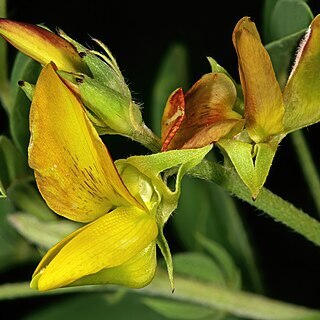Annual or short-lived perennial, with erect leading shoot to 80 cm and often long decumbent lower branches, usually appressed pubescent. Leaves 3-foliolate; leaflets variable, lanceolate or oblanceolate to oblong-elliptic or elliptic, mostly 2.5-5 x (0.2-)0.4-1.6 cm, thinly hairy at least beneath; petiole shorter to longer than the leaflets. Stipules shortly stalked, (2-)3-4-partite, the segments very shortly stalked, unequal, the proximal one linear-lanceolate to falcate, acuminate, very unequal-sided, 4-18 mm long, the others smaller. Racemes pedunculate, with ±6-12 flowers arranged laxly or rather closely towards the top; bracts filiform, 5-8 mm long, caducous. Calyx ±6.5-8 mm long, subglabrous or appressed pubescent; lobes subulate-triangular, longer than the tube, ultimately reflexed. Standard ovate-elliptic, yellow, glabrous outside; wings a little shorter than the keel; keel ± angled in the lower half with a well-developed ± straight beak lanate on the upper side, 10.5-14 mm long. Legume cylindrical, sometimes slightly inflated, 2.3-2.8(-3.2) cm long, abruptly contracted to a 3-4 mm long stipe, glabrous, ±8-12-seeded. Seeds subcircular-reniform, compressed with a slightly raised rim, ±5 mm in diameter, with a small aril, irregularly tuberculate, dull yellow.
More
Stipules shortly stalked, (2)3–4-partite; segments very shortly stalked, unequal, the proximal one 4–18 mm long, linear-lanceolate to falcate, acuminate, very unequal-sided, the others smaller.
Racemes often 6–12-flowered; bracts up to 4–8 mm long; pedicels 1–2.5 mm long.
Similar to C.podocarpa, distinguished certainly only by the divided stipules.
Branches usually appressed pubescent.

